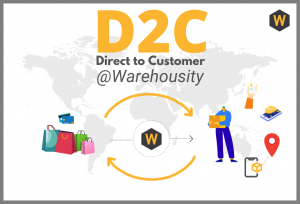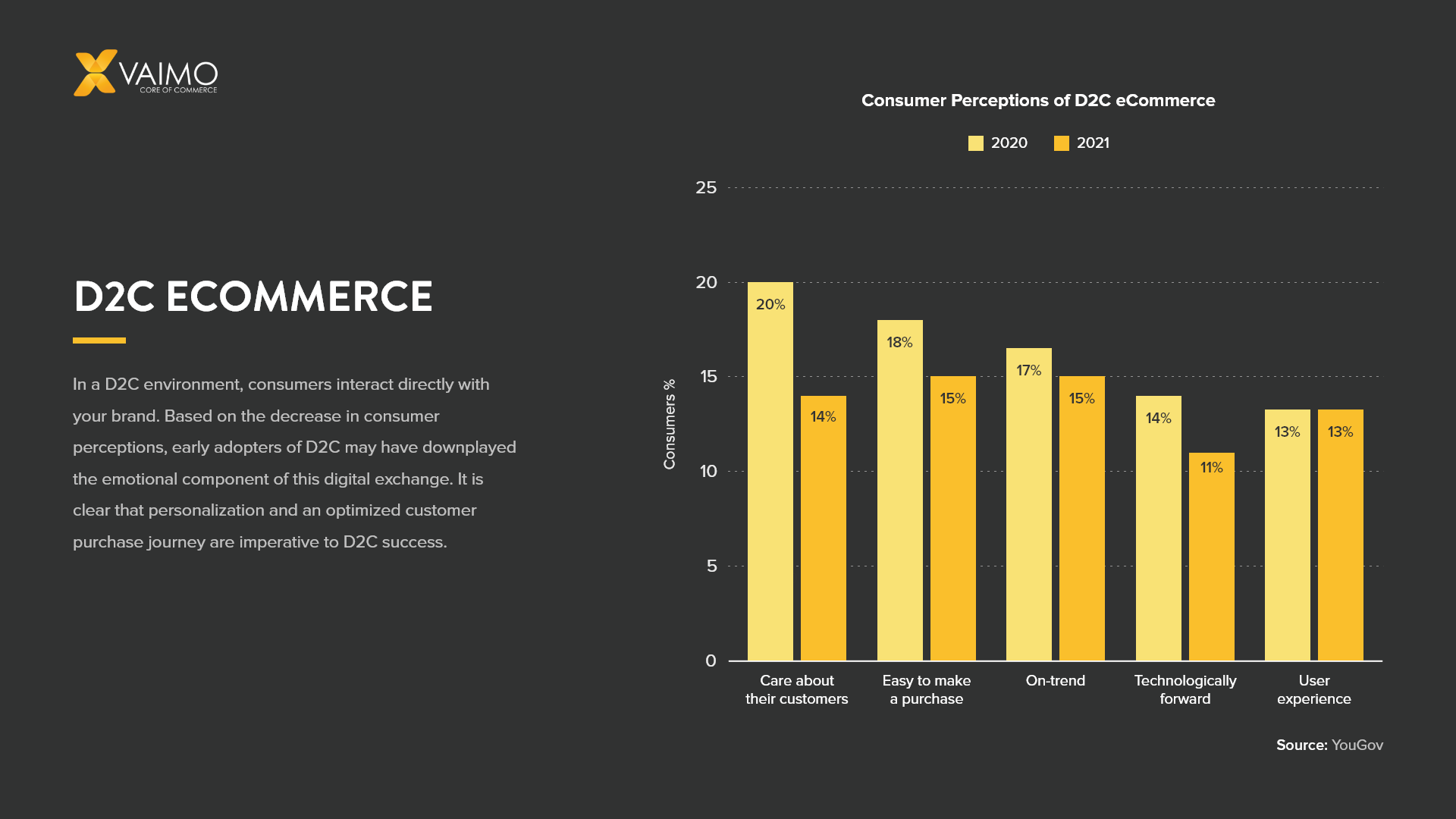Checking out the Prospective of D2C Ecommerce: A Comprehensive Guide for Businesses
The D2C ecommerce version provides a considerable shift in how brands engage with consumers. It makes it possible for business to bypass traditional retail channels, cultivating deeper connections and potentially increased profit margins. This strategy is not without its complexities. Understanding the nuances of D2C ecommerce is crucial for brands aiming to flourish. What strategies can they embrace to browse this developing landscape effectively? The responses might redefine their organization techniques.
Comprehending the D2C Ecommerce Version

Key Conveniences of D2C Ecommerce for Brands
The D2C ecommerce model supplies brand names significant advantages, specifically regarding raised profit margins. By eliminating middlemans, business can keep a bigger share of sales earnings. Additionally, this direct partnership with clients promotes boosted brand name commitment, encouraging repeat acquisitions and long-term engagement.
Increased Revenue Margins

Boosted Brand Name Loyalty
Structure on the economic benefits of D2C ecommerce, boosted brand commitment becomes one more crucial benefit for firms involving straight with customers. By developing a direct link, brands can promote deeper relationships with their clients, gaining insights into choices and behaviors. This straight interaction permits for even more individualized advertising strategies, which reverberate highly with customers. Additionally, brands have the possibility to manage their messaging and client experience, reinforcing brand name values and developing trust. When clients really feel a personal link, they are more probable to return, support for the brand name, and join community engagement. Inevitably, boosted brand name commitment not only drives repeat acquisitions yet likewise cultivates a passionate client base, additional solidifying a brand's setting out there.
Challenges Encountered by D2C Brands
D2C brands encounter numerous considerable difficulties that can influence their success. Supply administration issues can cause stock scarcities or excess, complicating procedures and consumer fulfillment. Additionally, marketing budget constraints often limit the ability to efficiently reach and involve target audiences.
Stock Management Issues
Effective supply management presents a formidable challenge for several brands running in the direct-to-consumer (D2C) area. These brands commonly face rising and fall demand, which can lead to overstock or stockouts, inevitably impacting consumer fulfillment and income. In addition, the absence of innovative supply radar can lead to inconsistencies in between real stock degrees and reported data, making complex order gratification. The varied variety of items D2C brands usually provide likewise makes complex supply monitoring, as variations in colors, dimensions, and styles require more meticulous oversight. Furthermore, many D2C services may battle with minimal warehousing capabilities, causing ineffective usage of room and sources. Reliable supply management stays a vital difficulty for D2C brand names aiming for lasting growth and operational performance.
Advertising Budget Plan Constraints
Steering advertising and marketing budget restrictions is a significant obstacle for several direct-to-consumer (D2C) brand names. Restricted monetary resources often restrict these firms' ability to invest in comprehensive advertising and marketing techniques, leading to reduced visibility in an open market. D2C brands frequently come to grips with the need to make the most of return on investment (ROI) while targeting particular audiences effectively. This challenge is exacerbated by climbing costs in digital marketing and the necessity to allot funds across several channels, including social media, online search engine, and e-mail advertising and marketing. As a result, many D2C brand names have to introduce cost-efficient marketing services, leveraging natural development techniques and influencer partnerships. Inevitably, successfully navigating these budget constraints is vital for sustaining growth and achieving long-term productivity in the progressing ecommerce landscape.
Methods for Building an Effective D2C Ecommerce Organization
As consumers significantly seek straight links with brand names, establishing a successful D2C ecommerce company requires a tactical method that focuses on consumer involvement and trust fund. One efficient strategy is to develop compelling brand narratives that reverberate with target market, promoting emotional connections. Making use of social media systems can boost presence and facilitate two-way interaction, enabling brands to engage directly with customers.Moreover, customized experiences through tailored advertising efforts can greatly boost consumer retention and commitment. Executing commitment programs and supplying special deals can even more incentivize repeat purchases.Streamlining the acquiring process is vital, ensuring an easy to use interface that improves the buying experience. In addition, clear interaction concerning shipping and returns develops trust and encourages consumer confidence.Finally, proactively seeking consumer feedback and reacting to it demonstrates a commitment to enhancement and consumer contentment, important aspects in the competitive D2C landscape.
Leveraging Technology for Improved Customer Experience
In today's competitive D2C ecommerce landscape, innovation plays a critical duty fit consumer experiences. Businesses progressively use sophisticated tools such as expert system, chatbots, and customized algorithms to enhance communications and enhance the purchasing process. By integrating these modern technologies, brands can provide customized item recommendations based upon specific preferences and shopping behaviors, promoting an extra interesting experience.Moreover, responsive site styles and mobile applications guarantee that consumers can access services perfectly across various devices. Enhanced payment remedies, including one-click check outs and digital purses, additionally simplify deals, making it simpler for customers to make purchases.Data analytics likewise enables organizations to collect insights into consumer behavior, permitting constant enhancement of services and offerings. Overall, leveraging technology not just enhances consumer satisfaction but likewise grows commitment, ultimately driving lasting success in the D2C ecommerce industry.
Advertising And Marketing Strategies to Drive D2C Sales
Just how can brands properly record the interest of consumers in a saturated market? To grow in the direct-to-consumer (D2C) landscape, brand names have to utilize targeted advertising and marketing techniques. Utilizing social media systems, brand names can engage consumers through interactive content, influencer partnerships, and user-generated posts. Personalized e-mail campaigns can likewise foster a sense of link, offering tailored promotions based upon consumer actions and preferences.Moreover, narration plays an important function in separating a brand name's narrative, making it memorable and relatable. Brand names must purchase seo (SEARCH ENGINE OPTIMIZATION) to improve presence, guaranteeing their items are conveniently discoverable online. Furthermore, leveraging data analytics permits organizations to fine-tune their marketing techniques and comprehend consumer patterns much better. Eventually, a multi-channel approach that combines creativity with data-driven insights can significantly boost D2C sales, permitting brand names to stick out in a crowded marketplace.
Future Patterns in D2C Ecommerce
With the rapid evolution of innovation and consumer choices, the future of D2C ecommerce is positioned for significant transformation. Arising fads show a shift in the direction of hyper-personalization, where brands take advantage of information analytics to customize offerings to individual customer requirements. This customization boosts consumer experiences, fostering commitment and engagement.Moreover, sustainability is coming to be a vital element, with consumers progressively favoring brand names that prioritize eco-friendly techniques - D2C Ecommerce Agency. Companies are anticipated to embrace transparent supply chains and sustainable materials to satisfy this demand.The assimilation of man-made knowledge and augmented fact will additionally transform the buying experience, enabling consumers to imagine products in their environments before acquisition. On top of that, social business is anticipated to grow, as platforms like read more Instagram and TikTok promote smooth buying experiences straight within social media.These fads jointly indicate a vibrant future for D2C ecommerce, emphasizing customer-centric strategies and ingenious innovations that redefine customer interactions
Regularly Asked Concerns
What Industries Benefit A Lot Of From D2C Ecommerce?
The present inquiry highlights industries that grow through direct-to-consumer (D2C) ecommerce. Remarkably, fashion, appeal, electronics, and food fields utilize D2C designs to increase brand name commitment, improve consumer relationships, and maximize revenue margins successfully.
How Do Shipping Costs Influence D2C Rates Methods?
Delivering prices greatly affect D2C pricing methods. Organizations should stabilize these costs with affordable pricing, taking into consideration client assumptions and earnings margins. Effective monitoring of shipping can enhance client contentment and drive sales in direct-to-consumer designs.
What Payment Alternatives Should D2C Businesses Offer?
D2C organizations must provide varied repayment choices, including credit/debit cards, electronic budgets, and get now, pay later services. This variety boosts consumer benefit, enhances conversion prices, and accommodates different consumer preferences in the on-line buying landscape.
How Can D2C Brands Deal With Customer Returns Properly?
D2C brands can manage customer returns properly by implementing straightforward return plans, offering pre paid delivery labels, and ensuring timely refunds (D2C Ecommerce Agency). Clear communication and structured processes improve client satisfaction and motivate repeat business
What Lawful Considerations Exist for D2C Ecommerce Procedures?
Legal considerations for D2C ecommerce procedures include conformity with customer defense laws, data personal privacy guidelines, copyright legal rights, and tax demands. Brands must navigate these intricacies to stay clear of legal pitfalls and guarantee smooth procedures. By getting rid of intermediaries, D2C brands can use affordable prices and promote a more intimate relationship with their customers.The D2C model is identified by its reliance on digital systems, enabling brand names to utilize social media, online markets, and their own internet sites to engage with customers directly. D2C ecommerce facilitates the collection of valuable consumer data, enabling brands to customize their offerings and advertising techniques effectively, inevitably driving sales and boosting margins. Additionally, brands have the chance to regulate their messaging and client experience, enhancing brand worths and building depend on. As customers increasingly look for straight links with brand names, establishing a successful D2C ecommerce service calls for a calculated method that focuses on client involvement and trust. D2C brand names can take care of client returns efficiently by implementing user-friendly return plans, using pre paid delivery tags, and making sure prompt reimbursements.